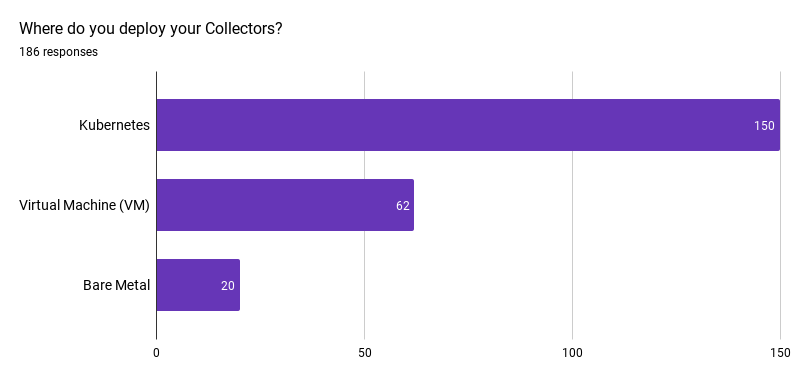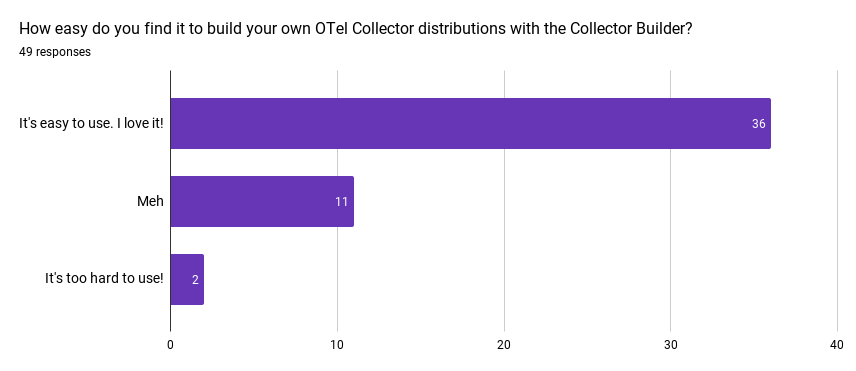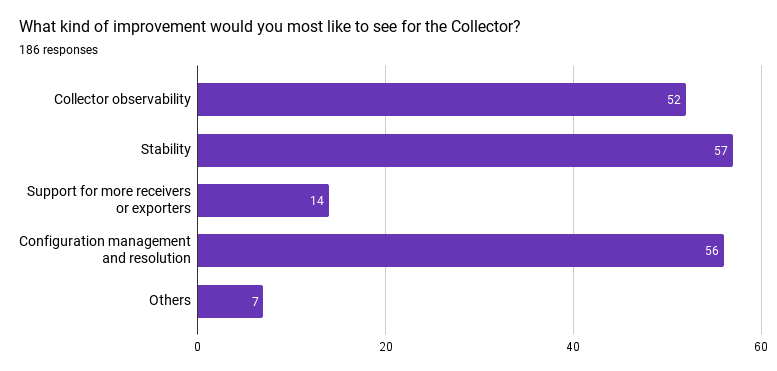Insights from the OpenTelemetry Collector Survey
The OpenTelemetry (OTel) Collector has become a cornerstone tool for observing and monitoring modern software applications. Recently, the End User SIG conducted a survey to gather feedback from users about their experiences with the OTel Collector. While we acknowledge that the 186 responses we received may not be statistically significant, they represent a great start and provide valuable insights. These insights include details about users’ deployment practices and implementation challenges, which are instrumental in helping to drive the OTel Collector’s future direction.
Key Takeaways
- Companies typically have medium to large collector deployments:
- >5 Collectors: 125/186
- >10 Collectors: 100/186
- Building custom binaries/distributions of the Collector is more popular than expected (61/186), with most people using the OTel Collector Builder to do so (49/61)
- The vast majority deploy the Collector on Kubernetes (150/186)
- There’s more desire for stability (59), self-observability (53), and config management (59), than for new components (14)
Detailed Insights
Deployment Scale and Environment
Our findings indicate robust use of the OTel Collector at scale, with 53.8%(100/186) of respondents deploying more than 10 collectors, 13.4%(25/186) running between 5 and 10 collectors, and 22%(41/186) running between 2 and 5 collectors.

Kubernetes is the leading platform for Collector deployment (80.6%), followed by virtual machines (33.3%) and bare metal (10.8%).

Usage Scenarios
The OTel Collector is primarily used as a gateway (64.5%), demonstrating its pivotal role in aggregating telemetry data from various sources. Daemonsets (51.6%) and sidecars (23.7%) are also popular deployment models, showcasing the flexibility of the OTel Collector in different operational contexts.

Customization and Configuration
A surprising number of people build their own distributions of the Collector (61/186), indicating that providing a composable Collector is important for the community. Most people who do build their own Collector distros use the OTel Collector Builder (OCB) (49/61). Of the 49 respondents who leverage the OCB, most were able to figure it out, with only 2 respondents stating that it’s too hard to use.

Monitoring and Observability
When it comes to monitoring the Collectors, a vast majority of respondents rely on Collector metrics and logs (81.7%), and only a few don’t monitor their Collector(s) at all (16.6%). When we peered deeper into the data, we found that of the 125 respondents with more than 5 Collectors, only 15 are not monitoring their Collectors, and of the 100 respondents with more than 10 Collectors, only 9 are not monitoring their Collectors. This seems to indicate that users take monitoring their Collectors seriously once they reach a certain maturity with their Collector deployments.

OTel Components Usage
The OTel Collector’s flexibility is vividly illustrated by the wide array of exporters, receivers, processors, connectors, and extensions that are used across various environments. This highlights the Collector’s capability to integrate with a vast range of tools and systems.
The top components according to our survey results are as follows:
Exporters
Receivers
Processors
Connectors
Extensions
- healthcheckextension
- basicauthextension
- pprofextension
- bearertokenauthextension
- oauth2clientauthextension
For a more detailed look at the specific exporters, receivers, processors, connectors, and extensions in use, you can check out the raw results. The data provides a clear view of the popular choices within the community as well as the niche configurations that exemplify the customizability of the OTel Collector.
Areas for Improvement
Respondents were clear about their desire for enhancements in stability (30.6%), configuration management and resolution (30.1%), and self-observability (28%), versus wanting new components (<8%)

The OTel Collector survey results offer a snapshot of the current state of Collector deployment and utilization. It’s evident that while the OTel Collector is widely adopted and highly customizable, there are also opportunities to make it more user-friendly and robust.
Keep in touch
Thanks to everyone who participated in the survey! We rely on your feedback to help guide the future development of OpenTelemetry and to ensure it continues to meet your evolving needs.
We will post upcoming surveys in the following avenues: #otel-sig-end-user Slack channel – you can also reach out to us here! End user resources page